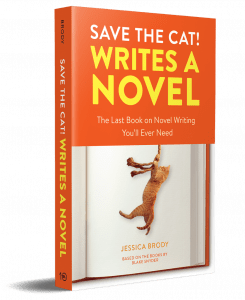 But did you know that the code doesn’t just appear in stories as a whole?
But did you know that the code doesn’t just appear in stories as a whole?
It can also be found in smaller chunks of narrative, like an individual scene or chapter? That’s right. I’ve recently discovered that many of the 15 beats that make up the Save the Cat! Beat Sheet can be found in scenes of books and movies. Not just in the plot of the book or movie itself. And since discovering this, I’ve started to use this to outline individual scenes and chapters in my novels before I sit down to write them, or when I’m trying to revise a particularly tricky scene that I can’t seem to get to work.
And similarly, in some of my older novels that I wrote before I discovered this little trick, I’ve found that scenes I LOVE (that seem to work especially well) tend to have many of the key beats that make up the Save the Cat! beat sheet. Meanwhile scenes that I struggled to write or that I still think fall flat, don’t have enough of those key beats. WHOA. MIND BLOWN.
 I’ll show you what I mean. I’ve taken the liberty of analyzing Chapter 1 of a very popular and successful novel called THE DAVINCI CODE by Dan Brown. As you can see, the scene has TEN of the 15 beats right there in this short 5-page chapter! And here they are:
I’ll show you what I mean. I’ve taken the liberty of analyzing Chapter 1 of a very popular and successful novel called THE DAVINCI CODE by Dan Brown. As you can see, the scene has TEN of the 15 beats right there in this short 5-page chapter! And here they are:
The Davinci Code by Dan Brown – Chapter 1 – Scene Beat Sheet
- SETUP – Robert Langdon wakes up to a phone call. We get a glimpse of his hotel room and discover he’s in Paris. It’s the middle of the night.
- CATALYST: Langdon picks up the phone and the hotel concierge tells him he has a visitor with an urgent message.
- DEBATE: What visitor? Who could this be? In trying to answer the Debate question, we learn that Langdon gave a talk at the University of Paris tonight and believes he might have ruffled some feathers. It’s probably a religious scholar who had followed him back to the hotel to pick a fight.
- BREAK INTO 2: Robert makes a decision on how to handle the situation and tells the concierge to take a message and tell the visitor he will call him.
- FUN AND GAMES: Thinking he’s dealt with the issue, Langdon remembers more of the recent evening, a flashback during which we learn that Langdon is a famous symbologist who recently had a somewhat embarrassing article written about him in the Boston Globe.
- MIDPOINT: False Victory. Langdon’s seeming “success” of dealing with the strange call a few minutes earlier turns out to be false when the concierge calls again to tell him this mysterious “visitor” is now on his way to up to his room, because the concierge, “cannot presume the authority to stop him.” (Stakes are raised.)
- BAD GUYS CLOSE IN: The knock comes at his hotel room door and the visitor is revealed to be none-other than a Police Lieutenant who tells him that the Police captain is requesting Langdon’s expertise in a “private matter.” This bizarre situation is starting to feel more and more perilous.
- ALL IS LOST: When Langdon asks about this “private matter”, the Lieutenant slides a photograph under the door that was taken inside the Louvre tonight. The picture shows a a dead Jacques Sauniere (whom Langdon was supposed to meet earlier tonight but who never showed up). His body is positioned very strangely. (Whiff of Death)
- DARK NIGHT OF THE SOUL: Why was he positioned like that? Langdon asks this very question to the Lieutenant who tells him…
- BREAK INTO 3: Monsieur Sauniere did that to himself. [end of chapter]
Ending a chapter or scene on the Break into 3 beat, or even on the All is Lost beat is an effective and common strategy because those are the beats that would usually form a cliffhanger or a question to be answered, leading to the next scene/chapter where the answer to that cliffhanger or question becomes the new scene’s Setup. And on and on it goes!

Imagine if every scene or chapter in your novel had Catalysts and Midpoints and All is Losts. What an exciting, non-stop, page turner that book would be! Now it’s important to note, “scene beat sheets” are going to feel much LESS dramatic than full plot beat sheets. We can’t have EVERY scene have life-changing stakes and mind-blowing plot twists, but we can create scenes that are dynamic and interesting, simply by making sure our scenes have at the very least the following beats:
Scene Beat Sheet Template
- SETUP: An introduction to the scene, giving us a small bit of information about who the character is and where they are (literally and metaphorically) at this moment of the story.
- CATALYST: Something that happens to send the scene in a new direction (even if it’s just a slight shift). Sometimes this is just a question that’s asked, or a goal/situation/opportunity that’s presented to the character.
- BREAK INTO 2: A decision or active step that a character makes in the scene usually in an effort to answer the Catalyst question or pursue the Catalyst goal/situation/opportunity. (Note: this can be as simple as wanting to get someone off the phone and go back to sleep, like in the example above.)
- MIDPOINT: A moment in which the character feels like they’re succeeding or failing in the above mentioned goal/situation/opportunity (False Victory/False Defeat), AND some kind of twist that sends the scene in another direction or raises the stakes of the scene.
- ALL IS LOST: A low point in the scene, usually coming with a sense of defeat or failure, or another turning point/twist.
- BREAK INTO 3: Possibly another active step that will catapult the character and the reader into the next scene (Note: This beat can also come at the start of the next scene/chapter as the new Setup.)
So there you have it. A proven template for making every scene or chapter in your novel dynamic and engaging. Give it a try. Find a problematic scene in your own current work in progress and see if you can identify which beats are missing. What happens when you try to restructure and rewrite using the template above. Does it help???
Good luck!